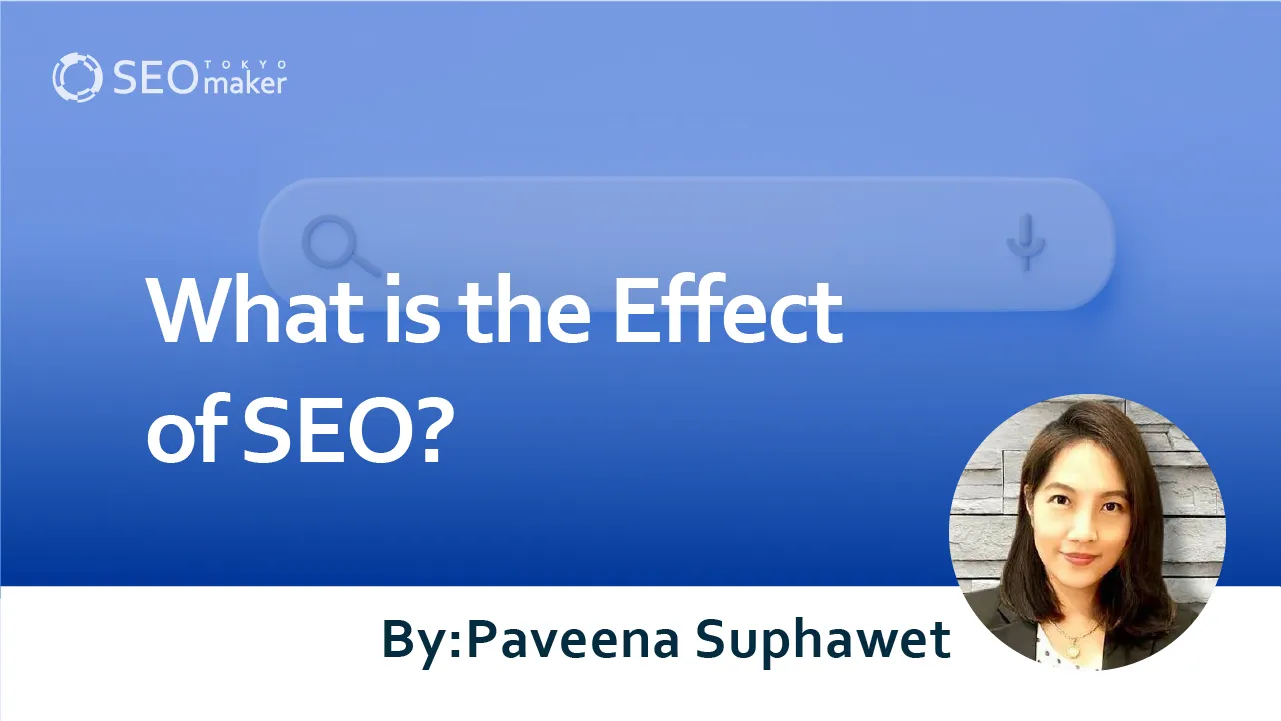What is the Effect of SEO? Explaining the Time It Takes for SEO to Show Results and How to Achieve Them
contents
 Many who have implemented SEO might wonder how long it takes to see results, as they haven’t noticed any effects yet. While the exact timeframe can vary depending on the specifics of the website, it is possible to make some educated guesses based on the measures implemented.
Many who have implemented SEO might wonder how long it takes to see results, as they haven’t noticed any effects yet. While the exact timeframe can vary depending on the specifics of the website, it is possible to make some educated guesses based on the measures implemented.
In this article, we will discuss how long it typically takes for SEO efforts to yield results, explore strategies for improving search rankings, and address common mistakes in SEO tactics. If you are a complete beginner, you might want to read “What is SEO? The Complete Guide to SEO in 2023 – Explaining Strategies for Ranking Higher” before proceeding with this page.
What is the Effect of SEO?
SEO, or Search Engine Optimization, involves strategies aimed at achieving higher rankings in search engines like Google and Yahoo! Japan. The effect of SEO refers to the outcomes and situations that occur after achieving these higher rankings. Generally, being ranked within the top ten search results is considered a high ranking, and significant SEO benefits are typically not realized outside of this range.
When search users look up certain keywords, having your site appear on the first page of search results indicates that your SEO efforts are effective. However, the difficulty of achieving this varies based on the search volume of the keywords and the competitive landscape, which also affects the specific criteria for each keyword targeted.
Achieving higher search rankings increases click-through rates and drives more traffic to your site, among other positive effects for online customer acquisition.
Benefits Achieved Through SEO
The greatest benefit of SEO is its ability to attract high-potential users. Simply operating a website without optimization won’t make it discoverable, which is why it’s crucial for website operators to proactively approach this strategy. SEO also offers long-term cost-effectiveness and branding benefits, among other advantages.
Here, we will delve deeper into the benefits that can be achieved through SEO.
Attracting High-Potential Users
The first benefit is the ability to attract users who are highly likely to engage with your business. Without SEO, a website can’t as effectively target the specific user demographics it wishes to reach. SEO allows for targeted keyword strategies, which help to understand and cater to certain user groups and their psychographics.
For example, if you run a budget hair removal salon in Shibuya, you might target keywords such as “hair removal salon Shibuya” or “affordable hair removal salon Shibuya”.
By focusing on specific keywords, site operators can choose their clientele, thus attracting users who are more likely to convert.
Cost-Effectiveness Compared to Web Advertising
Another benefit of SEO is its cost-effectiveness over the long term compared to web advertising. While SEO requires a long-term strategy and may not involve substantial upfront costs, web advertising can provide immediate results if the budget allows.
However, continuous high advertising costs are necessary to maintain effectiveness. Thus, both SEO and web advertising have their own advantages and disadvantages. In the long run, achieving a top search ranking through SEO could yield customer acquisition effects comparable to those of web ads, but without ongoing costs, making it an extremely cost-effective method of attraction.
Contributing to Branding
The third benefit is the impact on company and product/service branding. In search engines, users must input keywords, so if your company consistently ranks high for relevant searches, it introduces users automatically to your page titles and company name. Sites that rank high in organic searches are seen as more trustworthy, enhancing brand strength.
Ultimately, this can lead to associations like “hair removal salon = your company name,” embedding your brand in the context of relevant search terms. Thus, high search rankings not only drive site traffic but also effectively enhance company recognition and branding.
Time It Takes for SEO Efforts to Show Results
Just because you start implementing SEO strategies doesn’t mean you’ll see immediate results. If your targeted keywords begin to rise in rankings within about three months, you can consider that a success. Keep in mind that SEO is a long-term strategy.
I’ll share two key points and four examples regarding the time it takes for SEO effects to manifest.
Varies by Site
The time it takes for SEO effects to appear is not the same for every site. This variance is due to factors such as the strength of the domain and the competitiveness of the keywords. The strength of a domain is enhanced over time by acquiring quality external links and increasing the number of content pages indexed—a measure of how strongly it is evaluated by Google’s algorithms.
For newly created sites, the domain is still weak, and immediate SEO effects are unlikely. However, for older sites with strong domains, new content can be indexed and rank highly within days. Keyword competitiveness means that if there are few competitors for your targeted keywords, even new sites may quickly rank high. Conversely, even well-established sites with strong domains may struggle to rank high if the keyword competition is fierce.
Search Volume Also Affects Results
The search volume of keywords also influences how quickly you see SEO results. Generally, keywords with high search volumes are more challenging to impact with SEO and harder to rank for. For domains less than a year old, it often takes more than six months to see SEO effects. Some sites might show results in two to six months, but these are usually targeting keywords with lower search volumes or have a substantial amount of content. Targeting less competitive long-tail keywords in the initial stages of content creation is also a strategic approach.
Example Where Results Were Seen in About Three Months
Rather than typical SEO content, we continuously added unique research cases of around 1500 words each and saw visible growth after approximately three months. As we kept adding more unique cases, we managed to rank on the first page for our targeted keywords, and our session numbers greatly increased.
SEO Consultant’s Comment: Producing unique reports that competitors couldn’t replicate proved effective. Initially, there was a period of stagnation, but thanks to updates, we successfully increased our traffic. The keywords were niche, but we secured substantial access with middle-range keywords.
Example Where Results Were Seen in About Seven Months
By consistently publishing about 20 pieces of content monthly, we continued to see growth in sessions, which further accelerated in the seventh month.
SEO Consultant’s Comment: Big keywords were highly competitive, especially ‘Know’ type queries which were challenging. Top competitors often dominated with video content, so we focused on middle and small keywords with text-based strategies, which resulted in significant growth.
Example Where Results Were Seen in About Six Months
This site saw growth through persistent SEO efforts.
SEO Consultant’s Comment: The site already had some traffic but after fine-tuning internal links and HTML coding, and significantly increasing content, it benefitted from the update, boosting sessions. We managed to get onto the first page for keywords with over 20,000 monthly searches.
Example of Continued Growth Post-Update and After Ending SEO Efforts
This is a somewhat unique case. The site was set up and content was created from scratch, but due to client circumstances, only 30 articles were produced over five months.
While initial traffic was not impressive and no further actions were taken post the five-month mark, the SEO content, which had been carefully selected and researched, started to pay off later. Traffic continued to grow even without ongoing updates, and it still sets new records today.
Consultant’s Comment: This example shows that even with a small number of articles, well-crafted unique content can yield effects later on. While nothing was done for about two years post updates, the traffic continued to grow, indicating that continued content delivery could have significantly enhanced the results.
Strategies for Effective SEO
In this section, we will explore seven strategies for achieving effective SEO results. For a detailed understanding of SEO, please refer to “What is SEO? [The Latest Guide to SEO] Explaining Measures for Higher Rankings | The Complete 2022 Edition.
-Creating Unique Content that Meets Search Intent
-Targeting Long-Tail Keywords
-Optimizing Internal Links
-Eliminating Duplicate Content
-Revising the Quality of Content
-Implementing Constant SSL
-Improving Page Speed
Creating Unique Content that Meets Search Intent
While creating content is fundamental, the crucial aspect is that it meets the search intent and is unique.
Content that rehashes common knowledge is unlikely to be valued highly. Conversely, articles that present unknown information or unique capabilities of your company enhance originality.
Consider what users are thinking when they search and aim to provide the optimal answers. Producing excellent content and correctly implementing internal links can facilitate better crawling and lead to higher rankings.
Furthermore, ensuring your content is crafted with proper HTML and utilizing structured data can enhance rendering accuracy, improving page comprehension by search engines.
Targeting Long-Tail Keywords
Long-tail keywords are phrases composed of several words, typically with a monthly search volume of under 1,000.
For example:
-“men’s hair removal salon Hokkaido”
-“sauna with outdoor air bath Niigata”
At first glance, these might seem to have low search volumes and limited demand. However, long-tail keywords are recommended for achieving SEO success because there are fewer competing websites targeting these terms, making it easier to understand and meet the needs of search users. Simultaneously targeting long-tail keywords can also increase overall website traffic and improve SEO ratings. Therefore, instead of choosing highly searched keywords, it is crucial to first select keywords where you can realistically achieve high rankings.
Optimizing Internal Links
Once you create content, linking from existing pages is essential. Pages without internal links (isolated pages) are harder to crawl and take longer to be evaluated.
Internal linking strategies include links from the global menu, breadcrumbs, in-page links, and links from sidebars or footers.
Implementing internal links and improving navigation to encourage site exploration is a crucial strategy in SEO. Considering navigation improves user interface and user experience (UI/UX) and also enhances crawlability.
[Side Story] An Example Where Ranking Improved Just by Optimizing Internal Links
Internal links guide to related pages and, with the use of anchor text, help search engines better understand page content. However, they are often underrated in SEO. While not as impactful as external links, improving internal links can significantly influence your site. Successful sites often feature extensive internal linking.
If you’re wondering how many links are sufficient, just add as many as necessary—there’s no problem with having 100 if that’s what’s needed.
Eliminating Duplicate Content
As you manage a website and publish more articles, inevitably, some content may overlap. However, if duplicate content occurs, it’s crucial to remove one of the pieces and unify the content into a single entry. In SEO, duplicate or copied content can lead to lower evaluations from Google. Ignoring it can not only have negative effects but also result in penalties.
Revising the Quality of Content
Regularly review the quality of your content. This is because other sites are continually improving, and if your content does not evolve, it will eventually be surpassed. Also, the search intent behind keywords can change. While significant shifts are rare, if your content no longer aligns with search intent, it won’t satisfy users, and your SEO ranking may decline. Therefore, continuously strive for high-quality content that satisfies users whenever they visit your site.
Always-On SSL
Always-On SSL refers to changing your site’s URL from starting with ‘http’ to ‘https’. There was a time when SSL was considered a SEO strategy, but it doesn’t directly affect SEO rankings. If all other factors are equal, a site with SSL might have a slight advantage.
However, without Always-On SSL, Chrome will display a warning that the connection is not secure, which can lead to user abandonment. Simply from a security enhancement perspective, implementing SSL increases trustworthiness, which might indirectly affect SEO due to factors like time spent on site and bounce rates.
[Side Story] SSL which is not related with SEO
Strictly speaking, SSL does relate to SEO, but merely implementing SSL does not improve search rankings. Some SEO companies may promote SSL aggressively as a ranking solution, but it doesn’t directly boost rankings. From a security standpoint, SSL is advisable, and in today’s digital age, not having SSL is not an option. However, remember that SSL does not directly enhance SEO.
Page Speed Improvement
Page speed is a crucial metric linked to Core Web Vitals. Slow loading can lead to user abandonment, and excessively slow speeds can result in lower search engine rankings.
Thus, page speed does have a direct connection to SEO.
Page speed optimization is complex and multifaceted, but it’s recommended to start with achievable steps. Using AMP (Accelerated Mobile Pages) can dramatically improve mobile page speeds, though AMP itself doesn’t directly affect SEO rankings.
[Side story] Pros and Cons of AMP
Using AMP enables faster mobile page loading, which can significantly reduce abandonment rates. Especially if you’re using WordPress, AMP can be easily implemented and is effective. However, AMP might cause layout issues or require coding adjustments, so it’s wise to consult with engineers before implementation.
Ineffective SEO Tactics In this section
We’ll discuss ineffective and incorrect SEO tactics that you should avoid, primarily those that violate Google’s Web Search spam policies.
“-Cloaking
-Doorway pages
-Hacked content
-Hidden texts and links
-Keyword stuffing
-Link spam
-Automated traffic from bots
-Malware and malicious behaviors
-Misleading functionalities
-Unauthorized duplicated content
-Deceptive redirects
-Spammy auto-generated content
-Thin affiliate pages
-Spam created by users
-Other practices that could lead to demotion or removal from rankings
Source: Google Web Search Spam Policies | Google Search Central
Also, pay special attention to these tactics.
Intentionally Created Backlinks
Refrain from intentionally setting up backlinks just to increase them. Previously, search engine rankings were influenced by the number of backlinks, but now malicious backlinks are swiftly penalized and easily identified by search engines for their irrelevance. Focus on acquiring natural links rather than using dishonest methods.
Misuse of Anchor Texts
Anchor texts are the clickable texts used for links within a website. Misusing anchor texts to redirect to unrelated pages is prohibited and misleading. Ensure that your anchor texts and the links’ content align correctly without unnecessary keywords or phrases for proper usage.
Clickbait
Clickbait refers to the practice of using misleading titles that don’t reflect the actual content, designed to entice clicks. Also known as ‘bait headlines,’ it is a deceptive tactic used to lure users to content. Repeated use of clickbait can drive away users and fans, even without Google penalties, so it’s best to avoid such nuisances.
Key Points for Measuring SEO Effectiveness
This section explains key points for measuring the effectiveness of SEO strategies.
-Checking Search Rankings
-Monitoring Search Traffic
-Tracking Conversions
Checking Search Rankings
Search rankings provide a clear measure of SEO effectiveness and help gauge the current state. As rankings fluctuate daily, it’s important to monitor them over the long term. Utilizing tools like search rank checkers, which offer automatic tracking and keyword management, can simplify this process. These tools are especially recommended as managing numerous pages manually is labor-intensive and complex.
Recommended article: What is SEO Ranking? How to Check Search Rankings and Recommended Tools
Monitoring Search Traffic
When checking your website’s search traffic, using Google Analytics is highly recommended. The key aspect to monitor is the number of visits from organic search. Analyzing organic search traffic helps you understand how many users are accessing your site via search engines. An increase indicates a good state for SEO, while a decrease suggests there is room for improvement.
Recommended article: What is Web Analytics? A Comprehensive Guide from Basics to Analytical Techniques
Tracking Conversions
When checking conversions, just like with search traffic, utilize Google Analytics. The key point to check is the specific numbers for assisted conversions. Analyze how many users, who arrived via search engines, achieved the set conversion goals and determine if the search traffic was meaningful.
Recommended article: What is a Conversion? Explaining Conversion Rates and Tips for Improving CV Numbers in SEO
Summary
In this article, we’ve covered how long it takes for SEO efforts to show results, strategies for improving search rankings, and common missteps. While it’s difficult to precisely predict the timeframe for SEO results, you can estimate it based on the strategies employed. It’s crucial to focus on effective strategies, so be sure to note them. To speed up SEO results, it’s important to get your content pages indexed by Google. For new sites, submit a sitemap via Google Search Console, and for newly created content pages, applying for indexing through Google Search Console can result in indexing within a few days, thus accelerating SEO effectiveness.










![What is a Description? Explaining the Meaning, Writing Style, and Changing Word Count – [2023 Edition]](https://www.switchitmaker2.com/en/wp-content/uploads/2024/09/what-is-description.webp)










